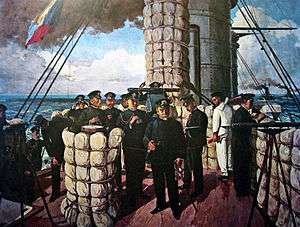Mantlet
A mantlet was a large shield or portable shelter used for stopping projectiles in medieval warfare. It could be mounted on a wheeled carriage, and protected one or several soldiers.
In the First World War a mantlet type of device was used by the French to attack barbed wire entanglements.[1]
 A wicker U-shaped mantlet on wheels. Wicker was a popular material for siege defences as it was lightweight, effective and easy to construct. The wheels add further mobility which meant that the user could move forward slowly but surely.
A wicker U-shaped mantlet on wheels. Wicker was a popular material for siege defences as it was lightweight, effective and easy to construct. The wheels add further mobility which meant that the user could move forward slowly but surely. A wood-planked, L-shaped mantlet on wheels. Wooden-planked construction with proper joinery and even arrow slots would make this a more hard-wearing and expensive option. It would be heavier to push and would require more time and skill to construct; this might not be the sort one would use when attacking uphill.
A wood-planked, L-shaped mantlet on wheels. Wooden-planked construction with proper joinery and even arrow slots would make this a more hard-wearing and expensive option. It would be heavier to push and would require more time and skill to construct; this might not be the sort one would use when attacking uphill. A pavise (free standing shield) like wicker mantlet. This is probably the cheapest and simplest option, but it would not be as hard wearing and does not offer as much cover as the other variations.
A pavise (free standing shield) like wicker mantlet. This is probably the cheapest and simplest option, but it would not be as hard wearing and does not offer as much cover as the other variations. A wood-planked mantlet on wheels, affording the hard protection of a wooden structure but still being mobile. The lever-like handle would allow the mantlet to be pushed along and then held upright in a stationary situation.
A wood-planked mantlet on wheels, affording the hard protection of a wooden structure but still being mobile. The lever-like handle would allow the mantlet to be pushed along and then held upright in a stationary situation. The Japanese commonly used mantlets composed of bundles of blankets wrapped in a mattress to reduce the effects of shell shrapnel. Print of Admiral Togo aboard the Mikasa during the Battle of Tsushima (May 27, 1905).
The Japanese commonly used mantlets composed of bundles of blankets wrapped in a mattress to reduce the effects of shell shrapnel. Print of Admiral Togo aboard the Mikasa during the Battle of Tsushima (May 27, 1905).
Gun mantlet
In military use from pre-WW2 onward, a mantlet is the thick, protective steel frontal shield, usually able to elevate and depress, which houses the main gun on an armoured tank, examples being Tiger Tank, Sherman Tank and Churchill Tank .
gollark: I guess a pub/sub system *would* be better than the utter bees I have now, yes.
gollark: Okay, not hax really, but still.
gollark: Or, well, I can, but it would require major redesigns and I don't know how exactly.
gollark: We cannot.
gollark: ++tel status
See also
References
- It Nipped Its Way Through Wire Entanglements, Popular Science monthly, January 1919, page 30, Scanned by Google Books: https://books.google.com/books?id=HykDAAAAMBAJ&pg=PA30
Further reading
- Farrow's military encyclopedia: a dictionary of military knowledge By Edward Samuel Farrow. Page 259
This article is issued from Wikipedia. The text is licensed under Creative Commons - Attribution - Sharealike. Additional terms may apply for the media files.